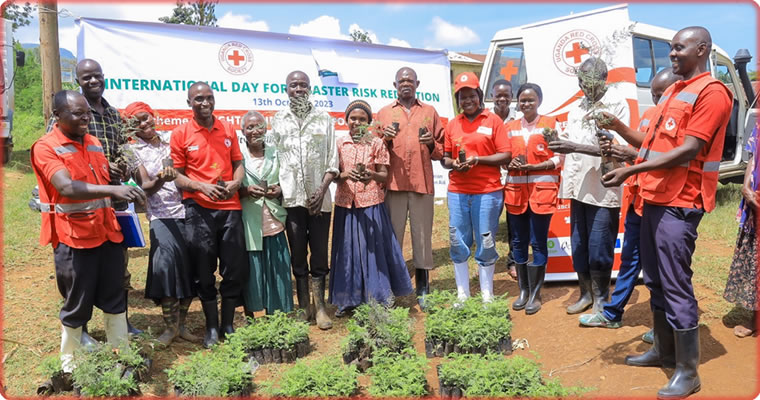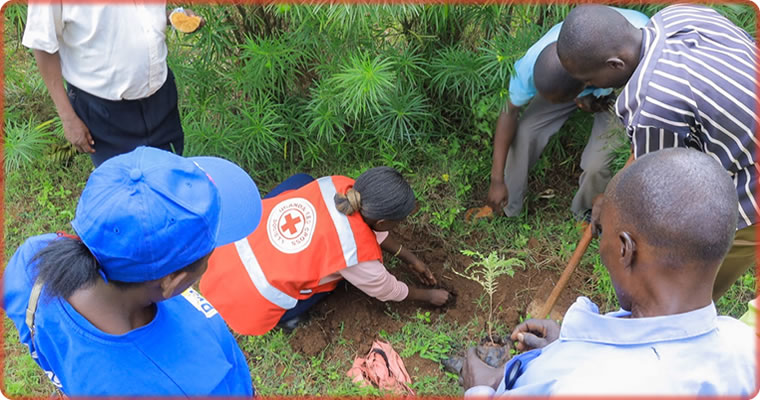The Uganda Red Cross Society (URCS) celebrated the International Day for Disaster Risk Reduction (IDDRR) by resuming their tree-planting initiatives in Eastern Uganda. The theme for this celebration was “Fighting inequality for a resilient future. Let’s Break the Cycle!”.
URCS focused on regreening the environment and distributed over 1500 tree seedlings to families in the Mt. Elgon region as part of the Strengthening Community-led Preparedness and Response project.
The communities that received the Grevillea Robusta seedlings were those at high risk of floods and landslides in the districts of Mbale and Sironko. Fifty families at high risk of flooding received 20 Grevillea Robusta tree seedlings each.
Additionally, fifty seedlings were given to Bukinyale primary school, and 200 seedlings were planted along the Sironko and Disi river banks in Sironko district. The remaining 300 seedlings were distributed and planted in Nashikhaso village, Bushikori Parish, Bungokho sub-county, located in the coffee city of Mbale District.

Brenda Atero, the project’s Emergency Preparedness and Response officer, and Sarah Orima Akello, the Climate Action and Environment Officer, led the URCS team during this initiative. They mentioned that the tree planting is part of the area’s Disaster Risk Reduction Village Action Plans, identified during the Enhancement of Vulnerability Capacity Assessment training that the community-based disaster risk reduction groups participated in.
Atero emphasized the importance of protecting the environment and implementing other action plans, such as digging trenches, creating contours, and opening drainage channels, to reduce the impact of floods and other disasters, especially with the rainy season approaching.
Sarah Akello Opimo, the Climate Action and Environment Officer at URCS, highlighted the role of Grevillea Robusta trees in reducing the risk of mudslides and controlling runoff, particularly in areas prone to flooding like Bukinyale in Sironko. She stressed the importance of proactive measures due to evidence of climate change in the region.
Local community leaders expressed their gratitude for the tree-planting efforts. Mathew Chana, the LC1 chairperson of Bukinyale village, noted that the river banks historically flooded and damaged their property, but with these efforts, they were optimistic that the effects would be minimized. Moses Girud, the LCII chairperson, highlighted how the planted seedlings would help trap fast-running water and protect their gardens during rainy seasons.
The International Disaster Risk Reduction Day (IDDRRD) is celebrated globally to recognize progress in reducing disaster risk and losses while emphasizing that disaster risk is often influenced by human actions.

About the project. Oxfam, Uganda Red Cross Society (URCS), Caritas Tororo and Catholic Relief Services (CRS) are implementing the Strengthening Community-Led Preparedness and Response project to target the districts of Bududa, Butaleja, Mbale, Namisindwa, and Sironko in the Mount Elgon region of Eastern Uganda through interventions designed to strengthen community-led and local preparedness and response system. This is with funding from European Civil Protection and Humanitarian Aid Operations.
The World Bank Climate Risk Country Profile (2020) ranks Uganda at high risk of natural disasters, with over 200.000 Ugandans being affected by disasters each year. The country’s vulnerability is exacerbated due to its high levels of poverty and dependence on ‘climate sensitive’ sectors. Uganda is also vulnerable to the impacts of climate change, experiencing atypical shorter or longer rains and harsher droughts, which represent a threat to the ecosystem and people’s livelihoods. The country is vulnerable to natural hazards such as floods, earthquakes, landslides, storms and droughts, and subsequently, the risk of an epidemic such as cholera increase when poverty or natural disasters force people to live in crowded conditions without adequate sanitation.
